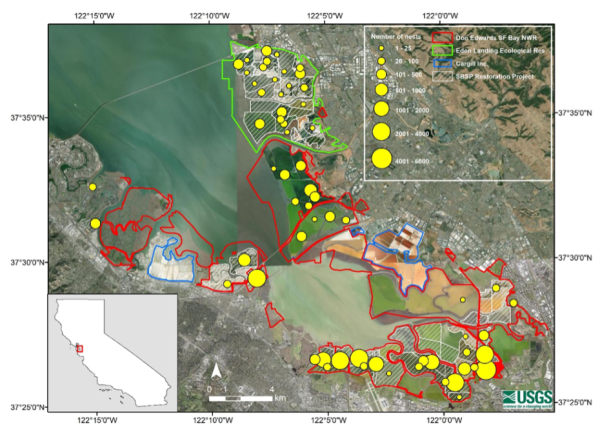San Francisco Bay supports thousands of breeding waterbirds annually and historically has hosted large populations of American avocets (Recurvirostra americana), black-necked stilts (Himantopus mexicanus), and Forster’s terns (Sterna forsteri). These three species have relied largely on former agricultural salt ponds in South San Francisco Bay, which provide wetland foraging habitat as well as island nesting habitat. The South Bay Salt Pond Restoration Project is in the process of restoring up to 15,100 acres of these former salt ponds to tidal marsh and tidal mudflats. Although this restoration is expected to have numerous benefits including providing habitat for tidal wetland-dependent species, improved water quality, buffering against storm surge and protecting inland areas from sea level rise, the reduction in former salt pond habitat and nesting islands therein may negatively impact breeding waterbirds. To address this, the South Bay Salt Pond Restoration Project also includes enhancements to remaining pond habitat such as the construction of new islands for nesting. Moreover, the South Bay Salt Pond Restoration Project follows an adaptive management plan in which waterbird response to the changing landscape is monitored over time to ensure that existing breeding waterbird populations are maintained. In this report, we provide results of waterbird nest monitoring in South San Francisco Bay during the 2022 breeding season and present these results in the context of annual nest monitoring in South San Francisco Bay since 2005. Overall nest abundance remained at or near 18-year lows for American avocets (176 nests) and black-necked stilts (97 nests), but Forster’s tern nest abundance (1,727 nests) was at an 18-year high, reversing historically low abundance observed during 2015-2017. In 2022, there were only 6 American avocet, 3 blacknecked stilt, and 4 Forster’s tern major colony nesting sites, down from annual averages of 12.4, 6.6, and 6.6 observed during 2005-2009. Nest success (30% for American avocets, 29% for black-necked stilt, and 53% for Forster’s terns) was below 2005-2007 baseline values established for the South Bay Salt Pond Restoration Project. Average egg hatching success (98%, 100%, and 90%), and clutch sizes (3.68, 3.70, and 2.63 eggs) of American avocets, black-necked stilts, and Forster’s terns, respectively, were similar to values observed during 2005-2010. All three species exhibited notable shifts in nest initiation dates in 2022, with American avocets and Forster’s terns nesting 10-11 days earlier and black-necked stilts nesting 10 days later than during 2005-2010. Finally, the enhanced managed ponds with newly constructed islands (Ponds A16 and SF2) supported 86% of all the Forster’s tern nests recorded in South San Francisco Bay in 2022, the first time these managed ponds have hosted such a substantial number of tern nests.
|
Species |
Number of nests |
Clutch size |
Nest success |
Egg hatching success |
Nest initiation date |
Vegetation height (cm) at the nest |
Percent vegetation cover at the nest |
Percent bare ground at the nest |
|---|---|---|---|---|---|---|---|---|
|
American avocet |
176 |
3.68 (3.56 - 3.85) |
30% (17 - 44%) |
98% (95 - 100%) |
May 4 (April 9 - June 5) |
6.5 (5.8 – 7.3) |
41.7% (36.5 – 47.0%) |
58.2% (53.2 – 63.2%) |
|
Black-necked stilt |
97 |
3.70 (3.55 - 3.85) |
29% (13 - 46%) |
100% (100 - 100%) |
May 13 (May 1 - June 25) |
12.0 (10.4 – 13.5) |
77.0% (70.2 – 83.7%) |
22.1% (15.7 – 28.6%) |
|
Forster's tern |
1727 |
2.63 (2.56 - 2.69) |
53% (41 - 63%) |
90% (86% - 93%) |
May 20 (May 11 – June 10) |
8.0 (7.5 – 8.4) |
56.4% (52.8 – 59.9%) |
44.1% (40.9 – 47.3%) |




